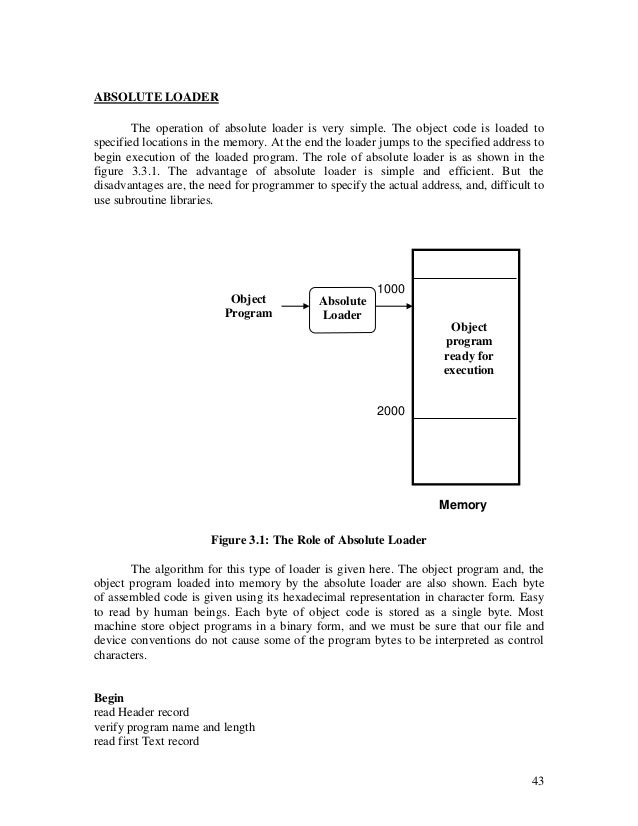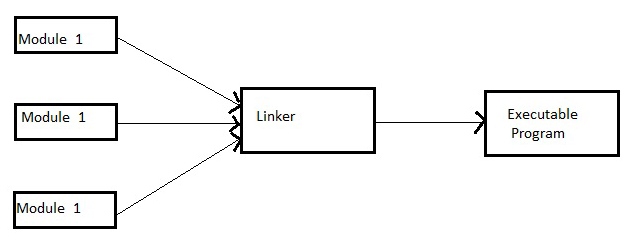Program For Absolute Loader
PDP-11 Paper Tape BASIC IntroductionThis page provides an overview of PDP-11 paper tape BASIC, and the computer equipment it was typically used with. It then describes how to load and run PDP-11 BASIC on real PDP-11 hardware, and how it can be run instead on a modern Windows-based PC, under the open-source SIMH PDP-11 simulator. Some sample BASIC programs are also provided, for demonstration purposes. Original HardwareDigital Equipment Corporation (DEC) released BASIC for its PDP-11 computers in approximately 1970. It was distributed on paper-tape, and was designed to be used on systems that had no other mass storage devices.
Program For Absolute Loader In C
It was typically used on the PDP-11/05 and PDP-11/10 computers in the early 1970s.PDP-11 BASIC was closely modelled on the original version of BASIC; Dartmouth BASIC. There are differences between the two languages, and these difference are documented in DEC’s PDP-11 Basic Programming Manual (see references section below).PDP-11 BASIC can be used on a minimal PDP-11 system with only 4kW (8kB) of core memory and a Teletype Model 33 teleprinter, provided the Model 33 is equipped with a paper tape reader and punch. In fact, PDP-11 BASIC is not ableto load programs from, or save them to, any other mass storage device (other than the optional high-speed paper tape reader/punch, as mentioned in the next section).The Model 33 teleprinter consists of a keyboard, printer, paper tape reader, and paper tape punch. It interfaces to the PDP-11 via a 20mA current loop interface (one loop for TX data, and a separate loop for RX data). The loops are powered by the PDP-11. They are not electrically isolated from the PDP-11, but they are isolated at the Model 33 end.

Data is exchanged in ASCII format at 110 baud. Keyboard and printer data consists of 7 data bits, followed by a parity bit always MARK parity) and two stop bits. This results in a data transfer rate of 10 characters per second (cps).

The Model 33 keyboard and printer only support upper case characters.A third current loop called Reader Enable is used by the PDP-11 to request an 8-bit byte of data from the paper tape reader. When the PDP-11 energises this loop, the paper tape reader sends one byte of data to the PDP-11 (via the RX data loop that is shared by the keyboard and paper-tape reader). By only energising the Reader Enable loop when it is ready to receive a byte from the paper tape reader, the PDP-11 controls the paper tape reader. Paper tape reader and punch data consists of 8 data bits, no parity bit, and 2 stop bits.All data transmitted by the PDP-11 on the TX data loop is printed on the Model 33’s printer. If the data is intended to be punched on paper tape, the user must manually engage the tape punch before the transmission begins. When the tape punch is engaged, all data sent by the PDP-11 via the TX data loop is both punched and printed.The user would enter, run and debug PDP-11 BASIC programs using the Model 33’s keyboard and printer.
Absolute Loader Slideshare
The paper tape reader is used to load the BASIC language itself, and to load user programs (in BASIC source code) that have been saved on paper tape. The paper-tape punch is used to save user programs (in BASIC source code). The BASICprograms can’t read or write their own data via paper tape. Instead, all I/O for the BASIC programs is via the Model 33’s keyboard and printer, other than data contained in DATA statements in the program itself.The Model 33 teleprinter uses PDP-11 I/O addresses 167. Optional high-speed paper tape reader/punchSome PDP-11 systems were equipped with an optional “high-speed” paper tape reader and punch.
The high-speed unit could read at 300 cps and punch at 50 cps, which is a big improvement over the 10 cps achieved by the Model 33 teleprinter.On systems equipped with a high-speed unit, the BASIC program itself, and user programs, would be read and punched on that equipment (instead of on the Model 33), leaving the Model 33 to be used just for keyboard input and printer output.The high-speed paper tape reader and punch uses PDP-11 I/O addresses 157. Adobe creative suite 4 serial number crack. Loading BASIC on a real PDP-11The focus of this page is on loading PDP-11 BASIC on a PDP-11/10. We will include the high-speed paper tape reader and punch in our hypothetical example.Step 1: Toggle in the bootstrap loaderThe PDP-11/10 does not have a BIOS or boot ROMs. So the computer does not automatically execute any code at startup. Instead, the initial startup program must be toggled in using the switches and LEDs on the front panel of the PDP-11.So using the front panel, we key in the Bootstrap Loader. The Bootstrap Loader varies from system to system, depending on the amount of memory installed and whether a high-speed paper tape reader/punch is installed.
The impact of these variables is explained in Appendix D of the Programming manual.For the purpose of this example, we will assume a high-speed paper tape reader/punch is installed, and the PDP-11 has 8kW (16kB) of core memory.Here is the Bootstrap Loader to be keyed in: Location Instruction001026002052011011076062002000067056065050Step 2: Loading the Absolute Loader from paper tapePosition the Absolute Loader paper tape in the high-speed reader. Set the Switch Register (through the front panel) to 037744, move the ENABLE/HALT switch to the ENABLE position, and press the START switch.The Bootstrap Loader will now load the Absolute Loader into memory.Step 3: Loading PDP-11 BASICSet the Switch Register to 037500 and press LOAD ADRS.
Now Set the Switch Register to 0. Position the 8k version of the PDP-11 BASIC paper tape in the high-speed reader. Now press the START switch. PDP-11 BASIC will be read in via the tape reader, and it will automatically start. Note: This paragraph needs to be verified by operation of the real machineStep 4: Configure PDP-11 BASICBASIC will type its name and version number, and then give you the following prompt: PDP-11 BASIC, VERSION 007A.OThis prompt is asking you to select “options”.
These are described in Section 7.1 of the Programming Manual. For the purpose of this example, just press RETURN on the Model 33.BASIC will now give you the READY prompt.Now you are good to go. Type in a program (with numbered lines), or enter commands for immediate execution.Some handy commands to know at this point are:LIST – to list all program lines in memorySAVE – to copy the current program from memory to paper tapeOLD – to load a program from paper tape into memoryDELETE – to delete all program lines from memoryIt is important to note that PDP-11 BASIC does not accept lower-case characters. This is not a problem when using a Model 33 teletype, as it only has upper-case characters. It could however be a problem if you are using a video terminal in place of the Model 33. Setting up PDP-11 BASIC on a Windows PCIt is possible to run PDP-11 BASIC on a Windows PC using the SIMH simulator.The setup process is described below.Step 1: Download and install the SIMH executableDownload and install the Windows executable version of the SIMH PDP-11 simulator. The download is a ZIP file with multiple files in it.
You only need a single file called pdp11.exe. There is no install process involved. Just place the file in an empty directory. The version I am using is 3.9.0.Step 2: Setup the SIMH configuration fileUsing a text editor, create a file called pdp11.ini in your SIMH directory.